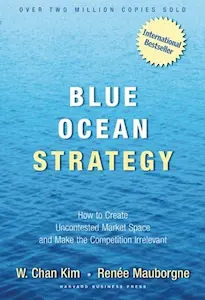Blue Ocean Strategy - Summary
W. Chan Kim and Renee Mauborgne

Introduction
In their groundbreaking book “Blue Ocean Strategy,” W. Chan Kim and Renée Mauborgne present a revolutionary approach to business strategy that challenges traditional thinking. The authors argue that companies should not compete in crowded, red oceans where competition is fierce, but rather seek out untapped, blue oceans of uncontested market space. By creating new demand and making competition irrelevant, organizations can unlock new opportunities for growth and success.
Understanding Blue Ocean Strategy
The central concept of Blue Ocean Strategy is the distinction between red and blue oceans. Red oceans represent existing industries where companies compete head-to-head, striving for a larger share of the existing market. In contrast, blue oceans symbolize unexplored market space where competition is nonexistent, allowing for the creation of new demand.
The authors provide numerous examples of companies that successfully implemented blue ocean strategies. One such example is Cirque du Soleil, a circus troupe that redefined the traditional circus industry. By combining elements of theater, music, and acrobatics, Cirque du Soleil created a new market space, appealing to a broader audience beyond just children. This innovative approach allowed them to charge higher ticket prices and attract a more sophisticated clientele, setting them apart from traditional circuses.
The Six Principles of Blue Ocean Strategy
To guide organizations in creating blue oceans, Kim and Mauborgne outline six principles that form the foundation of their strategy:
1. Reconstruct Market Boundaries
The first principle encourages companies to challenge industry boundaries and redefine the scope of their market. By looking beyond existing products and services, organizations can identify new opportunities for value creation. For instance, Yellow Tail, an Australian wine brand, successfully entered the wine market by targeting a younger, less sophisticated consumer segment with their affordable and approachable wines.
2. Focus on the Big Picture, Not the Numbers
The authors emphasize the importance of focusing on the overall value proposition rather than getting caught up in detailed financial analysis. By understanding what customers truly value, companies can deliver exceptional experiences that set them apart. For example, Southwest Airlines disrupted the airline industry by offering low-cost flights with a focus on customer service and efficiency, rather than luxurious amenities.
3. Reach Beyond Existing Demand
Blue ocean strategies require companies to look beyond existing demand and create new demand. This involves understanding non-customers and finding ways to attract them to the market. Nintendo’s Wii gaming console achieved tremendous success by targeting non-gamers, offering a more accessible and interactive gaming experience that appealed to a broader audience.
4. Get the Strategic Sequence Right
The authors stress the importance of getting the strategic sequence right to ensure successful execution of a blue ocean strategy. This involves developing a compelling value proposition, aligning the organization’s activities to deliver that value, and ensuring profitability. For instance, Starbucks transformed the coffee industry by creating a unique customer experience, aligning their stores, products, and service to deliver a premium coffee experience that customers were willing to pay a premium price for.
5. Overcome Key Organizational Hurdles
Implementing a blue ocean strategy often requires organizations to overcome internal hurdles and resistance to change. The authors provide guidance on how to address these challenges, such as aligning incentives and breaking down silos. One example is the Body Shop, which disrupted the beauty industry by offering ethically sourced and environmentally friendly products. However, as the company grew, it faced challenges in maintaining its core values and overcoming conflicts between profitability and social responsibility.
6. Build Execution into Strategy
The final principle emphasizes the importance of integrating execution into the strategy itself. Blue ocean strategies require a systematic and disciplined approach to ensure successful implementation. For example, the online streaming service Netflix disrupted the video rental industry by offering a convenient and personalized viewing experience. By continuously innovating and adapting to changing customer preferences, Netflix has maintained its position as a leader in the entertainment industry.
Conclusion
“Blue Ocean Strategy” presents a compelling framework for organizations to break free from the constraints of traditional competition and create uncontested market space. By reconstructing market boundaries, focusing on value, reaching beyond existing demand, and addressing key organizational hurdles, companies can unlock new opportunities for growth and success. Through the examples and anecdotes shared in the book, Kim and Mauborgne provide valuable insights into how companies have successfully implemented blue ocean strategies across various industries. Embracing this innovative approach can enable organizations to chart their own path to success in today’s highly competitive business landscape.